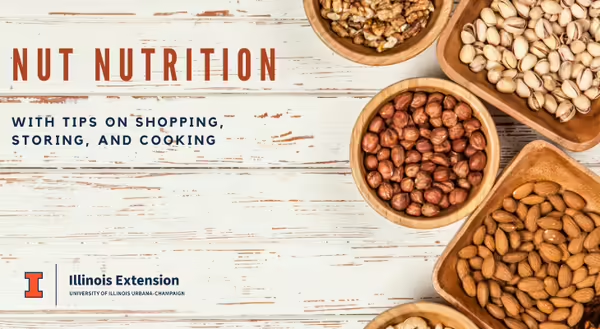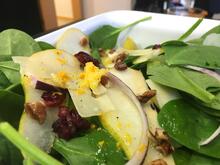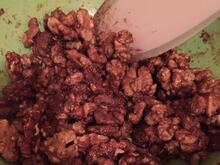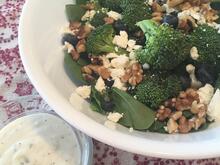
Are you nuts for nuts? If so, you probably have some favorites. Maybe pecans or walnuts? Peanuts or almonds? Fortunately, no matter your favorites, nuts are a nutritious choice!
Nutritionally, 1/4 cup of just about any nut contains around 200 calories, 14-18g fat, 5-7g protein, 2-4g fiber, and are sources of vitamins and minerals including vitamin E, some B vitamins, magnesium, zinc, potassium, and iron. On their own, nuts are not a significant source of carbohydrates or sodium.
- Buy:
- Raw nuts: Stores may sell raw nuts in-shell or out-of-shell and in bulk bins or pre-measured in sealed containers. Nuts are a high-fat food and that fat can become rancid over time, giving off flavors to the nuts. Check "best-by" or "use-by" dates to buy the freshest nuts available.
- Flavored nuts: Nuts may also be sold flavored, such as dry- or oil-roasted, candy-coated, or flavored with sweet and savory seasoning blends. Any of these flavorings can add fat, carbohydrates (primarily sugar), and sodium. To help reduce sodium in the diet, choose nuts that are unsalted or say "lightly salted." Often, sweetly seasoned and oil-roasted nuts do not add very much sugar or fat. Still, be sure to read the label to know what ingredients are in the nuts you are buying.
- Nut butters:
- "Natural" nut butters are only blended nuts (and maybe salt). The oil and nut solids separate over time and need to be stirred before using.
- In "no stir" nut butters, the oil is prevented from separating by adding palm oil or other ingredients. (The addition of partially hydrogenated oils, which are a source of trans fats, has mostly been phased out of nut butters.) These brands often have added salt and sugar. Check labels to know how much.
- Reduced-fat nut butters can have 25% less fat than the original product. Reduced-fat products may add sugar or salt to compensate for loss of flavor due to less oil. Because nuts and nut butters have heart-healthy unsaturated fats, it can be worth buying full-fat nut butters and using a smaller portion instead.
- Nut powders: By adding water, nut powders turn into a spreadable nut butter. Most brands are defatted, making the nut powder low in fat. While useable as a nut butter, nut powders can also be added to smoothies, baked goods, and oatmeal. Check if your nut powder is flavored, which may add sugar.
- Price: In general, nuts are expensive. Buying larger packages can cut down on the unit price (such as dollars per pound), but make sure you plan to use the nuts in a timely manner before they start to go rancid.
- Store: Most nuts can be stored at room temperature for several weeks and months. Nuts can also be refrigerated or frozen for longer storage. Follow any storage recommendations on the package. For example, many "natural" peanut butters recommend refrigeration after opening.
- Prepare:
- Unless the nuts are in the shell, simply open the package and eat. To cut nuts into smaller pieces, add nuts to a food processor or clean coffee grinder and pulse until you reach the desired size pieces. Or place in a sealed bag and lightly pound with the side of a meat mallet.
- If the nuts are in the shell, use a nutcracker carefully to remove the nut inside.
- Interested in roasting nuts? Watch this video from the Academy of Nutrition and Dietetics for tips.
- Preserve: Did you know you can pressure can green peanuts at home? Check out instructions from the National Center for Home Food Preservation.
- Make: It is not hard to make your own nut butters. See the DIY: Make your own nut butter article from Illinois Extension educator, Jenna Smith.
- Eat: As mentioned, nuts are high in fat. If you eat nuts daily, limit to a single serving of 1/4 cup nuts or 2 tablespoons nut butter. Nuts work well in a variety of sweet and savory recipes or simply as a snack. Check out some tasty recipes below!
Winter Fruit and Spinach Salad | Print recipe
Fruit and Nut Granola Bar Clusters | Print recipe
Spiced Nuts | Print recipe
Broccoli Salad with Blueberries and Feta | Print recipe
Pumpkin Pie Granola | Print recipe
Apple Tuna Salad | Print recipe
References:
- US Department of Agriculture, Agriculture Research Service, National Nutrient Database for Standard Reference
Post originally published in 2014; content updated in 2020.
Healthy Eats and Repeat
How much difference is there between canned and frozen foods? How should you cook venison? When is the best time to buy avocados? Get answers to these questions as well as other tips, tutorials and recipes for common kitchen foods and items with University of Illinois Extension Nutrition & Wellness Educator Caitlin Mellendorf’s blog Healthy Eats and Repeat. Build your best life. Trust Extension to help.
Caitlin Mellendorf is an Illinois Extension Nutrition and Wellness Educator serving DeWitt, Macon and Piatt Counties in Central Illinois. She is a Registered Dietitian and her work focuses on helping community members gain the knowledge, skills and tools to live healthier, more nutritious lifestyles. This includes providing programs and answering questions about heart health, diabetes, food safety, food preservation, grocery shopping and cooking. You can reach Caitlin by email at chuth2@illinois.edu or call 217.877.6042. Check out her nutrition blog Healthy Eats and Repeats for seasonal recipes and of an exploration of common kitchen foods.





